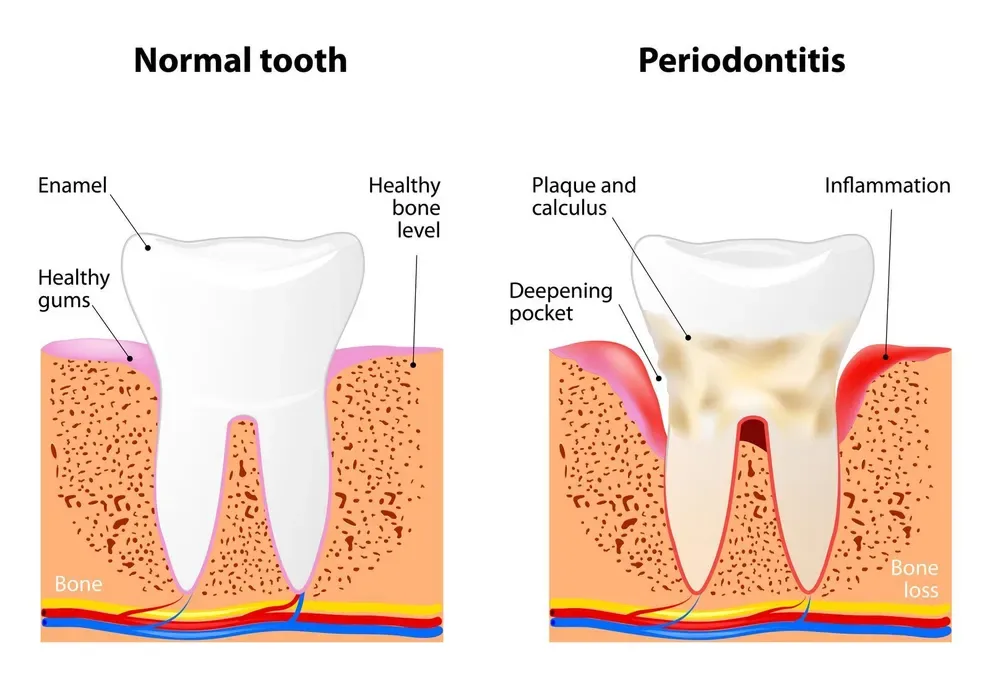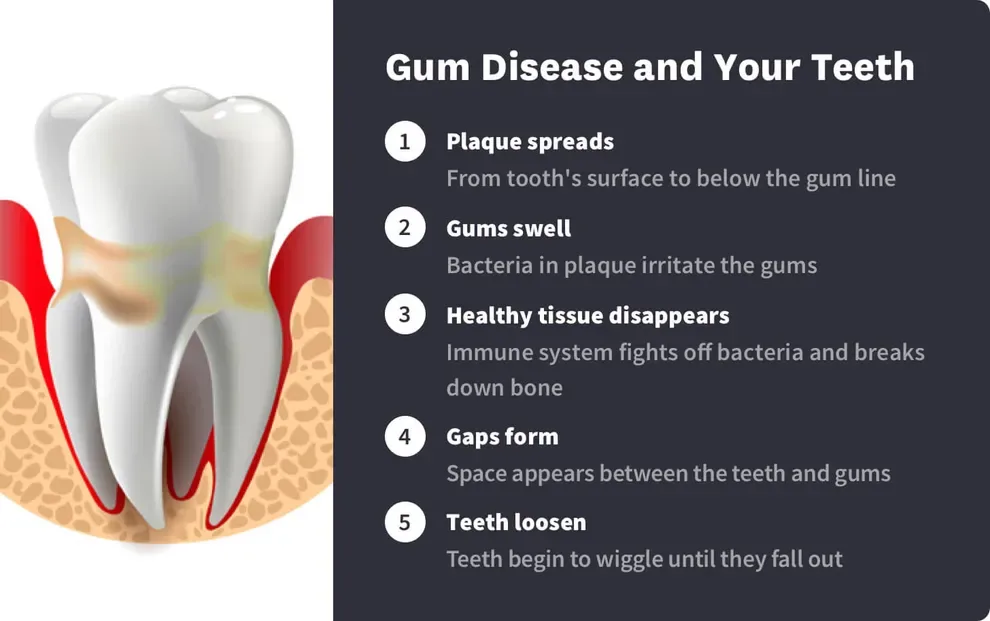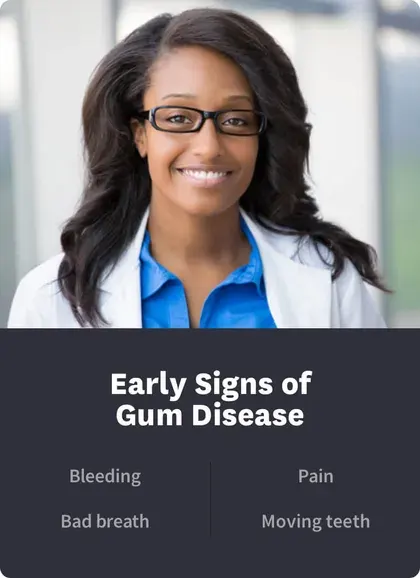The Dangers of Gum Disease: Tooth Loss & More

Table of Contents
- Gum Disease
- Gum Disease and Your Body
- Early Signs
- Diagnosis of Gum Disease
- Gum Disease Prevention
- References
Each time you pick up a toothbrush, you're doing more than caring for your teeth. With each move of your wrist, you're also caring for the gums that support your teeth.
Skip this critical dental hygiene step (and others like it, such as flossing), and you could put your gum health at risk.
Advanced gum disease is a top cause of tooth loss. Inflammation associated with the disorder can harm your body's health too, and you could develop conditions such as heart disease.
We'll explain how gum disease develops, and we'll offer a few commonsense steps you can take to keep your mouth as healthy as possible.

Gum Disease & Your Teeth
Several layers of gum tissue cradle each tooth inside your mouth. If you don't keep your gums healthy, you put the integrity of your entire smile at risk.
Gum disease follows a step-by-step progression:
Plaque spreads. The sticky substance moves from the tooth's surface below the gum line.
Gums swell. Bacteria in plaque irritate the gums, and they puff up as part of an inflammatory response.
Healthy tissue disappears. As the immune system attempts to fight off bacterial invaders, bone breaks down.
Gaps form. Space appears between the teeth and gums, allowing more bacteria to enter.
Teeth loosen. Without a firm layer of gum tissue and strong roots, teeth can't stay in place. They may wiggle and wobble until they fall out.
Gum disease is a major cause of tooth loss. And once a molar or incisor leaves your mouth, it can't be replaced. You'll need a bridge or some other form of artificial tooth to fill the gap left behind.
If you don't replace the lost tooth, your remaining teeth can shift to fill in the gaps left behind. The movement makes them even more unstable, which can lead to even more tooth loss.
How Gum Disease Affects Your Body
Inflammation is a critical part of gum disease. Your immune system works to fight the bacteria embedded in plaque, and that makes tissues swell. Sometimes, the swelling moves from your mouth into the rest of your body.
Gum disease has been linked to several other health problems like these:
Stroke
Diabetes
Heart disease
Pregnancy problems
Dementia
The connection is strong. For example, people with gum disease have up to three times the risk of having a heart attack or stroke as someone without gum disease.
Lifestyle choices could make the link even stronger. For example, if you smoke, you harm your gums with each puff you take. And chemicals found inside smoke could damage your heart and lead to cardiovascular disease.
But people who don't smoke can also develop gum and cardiovascular diseases in tandem. Inflammation likely ties them together.
Neglect your gums, and you could weaken your teeth's attachment to your jaw, while inflammation linked to gum disease could also spread to other parts of your body, including your heart.
Early Signs
Your gums grow and change throughout your life. But the damage caused by gum disease is irreversible unless you catch it early.

Warning signs to watch for include:
Bleeding. You may see blood on your toothbrush or dental floss. Sharp foods like chips may cause you to bleed too.
Pain. Your gums may be sore and swollen, and the discomfort makes you less likely to brush or floss.
Bad breath. As your gum health worsens, bacteria builds up in your mouth and leaves a stench behind.
Moving teeth. You may feel like your bite isn't the same as it once was. You might notice that your teeth feel loose or wobbly too.
These are a few signals that something is going very wrong in your mouth. But know that some people have no symptoms at all. They feel no pain or discomfort, their mouths never bleed, and they don't feel unhealthy. They have no idea a problem is happening until their teeth begin to fall out.
How Is Gum Disease Diagnosed?
If you spot issues with your smile, a visit to a dentist is critical. This professional can examine your mouth and assess your gum health. If you do have gum disease, your doctor can suggest treatments too.
Doctors use two tools when assessing your gum health.
Vision: Your doctor looks at your teeth and gums carefully. The doctor may notice redness, swelling, or pocket formation.
Probes: Your doctor pushes a pick into your gums in three places: the left side, the center, and the right side. Each poke comes with a measurement of gum depth.
After a thorough exam, your doctor may give you one of two gum disease diagnoses.
Gingivitis: Mild gum swelling with no pockets characterizes this disease. The damage can be reversed with proper care.
Periodontal disease: At least one pocket with 3 millimeters of attachment loss and 4 millimeters of pocket depth merits a diagnosis of periodontal disease.
Mild gum disease is treated with attention to hygiene. Your doctor will encourage you to focus on regular brushing and flossing, and you might need a mouthwash to kill bacterial colonies living inside your mouth.
Significant gum disease is treated with deep cleaning. Your doctor cleans the entire surface of your tooth and the roots of your teeth. Scaling and root planing can be uncomfortable procedures, but they can help to stop the disease progression and save your tooth.
If scaling and root planing don't help, your doctor may perform surgery to address bone loss and deeper infections. Your doctor can also use implants to replace the teeth you've lost to disease.
You Can Prevent Gum Disease
Take care of your gums, and you're less likely to lose your teeth or deal with inflammation-related disease.
Take three important steps every day.
Brush: Use a soft-bristled toothbrush covered with toothpaste after every meal. Swirl the brush around your teeth, but don't forget to push the brush along your gumline too.
Floss: A strand of dental floss can remove plaque, food, and bacteria trapped between your teeth. Make a plan to floss at least once per day.
Rinse: Use an alcohol-free mouthwash fortified with fluoride. You'll kill bacteria lingering in your mouth while freshening your breath at the same time.
If you're wearing braces, these steps are harder to follow. You have brackets and wires covering your teeth, and that makes reaching each tooth harder. The wires that connect braces also make flossing impossible.
Some people use specially designed brushes that can slide beneath braces wires, and they use water jets in place of flossing.
But it's very difficult to keep teeth perfectly clean and gums very healthy, while wearing braces. Teeth aligners can be a better choice, as you can remove the trays each time you need to clean your teeth. Aligners also leave your teeth bare during cleaning, so you can fully address each important surface.
If you spot warning signs of gum disease, visit your doctor right away. And know that a yearly visit to a dentist is important for your overall oral health. Regular cleanings performed by a professional can remove bacteria and plaque before they worsen.
